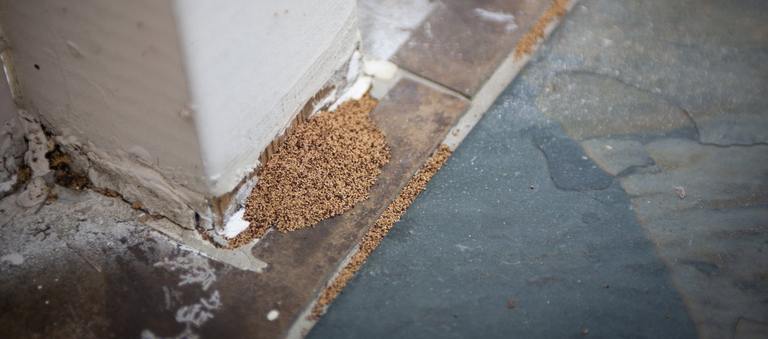Termite Droppings: Otherwise Known as Frass
Published: February 21, 2025

What Is Termite Frass?
Termites, though small, can be a homeowner's worst nightmare. One of the telltale signs of a termite infestation is the presence of termite droppings, also known as Termite Frass. Understanding what Termite Frass looks like, how to handle it, and how to differentiate it from other pests' droppings is crucial for maintaining a safe and healthy home environment. In this article, we will delve into it’s characteristics, compare it to carpenter ant droppings, and discuss the best practices for handling and cleaning up these potentially hazardous piles.
The term "frass" comes from the German word "Frassen," meaning "to eat." It refers to the excrement produced by insects that consume wood or plant material. For termites, frass is essentially their waste product after digesting wood fibers. This material can provide significant clues about an infestation. Termite Frass often accumulates near baseboards, windowsills, and other wooden structures, indicating the presence of drywood termites.

Characteristics of Termite Frass
Size and Color
Frass is typically very small, resembling tiny grains of sand or sawdust. It is usually about 1 millimeter in length and has an elongated shape with rounded ends. The color can vary depending on the type of wood consumed but generally ranges from light beige to dark brown. Unlike sawdust, Frass does not have a uniform texture as it consists of compacted pellets expelled from termite colonies.
Comparison with Carpenter Ant Droppings
Carpenter ant droppings differ significantly from termite droppings. While both may appear similar at first glance, carpenter ants produce larger pellets that are more irregular in shape. Additionally, carpenter ant frass often contains bits of chewed-up wood fragments and insect parts because they do not digest the wood as termites do. Identifying frass correctly is crucial because mistaking it for harmless debris can lead to undetected structural damage.
Handling Termite Frass
Potential Risks
Although frass itself is not toxic or dangerous to humans and pets directly, it indicates a severe underlying problem: a termite infestation that could compromise your home's structural integrity. Handling frass without proper precautions can expose you to allergens or irritants present in the material.
Safe Cleanup Practices
When dealing with frass:
- Wear Protective Gear: Use gloves and a mask to avoid direct contact with the droppings.
- Use Appropriate Tools: A vacuum cleaner with a HEPA filter is ideal for cleaning up fine particles like frass.
- Disinfect: After removing the frass clean the area thoroughly with soap and water followed by disinfectant spray.
Subterranean vs Drywood Termites
Subterranean Termites
Subterranean termites live underground create mud tubes for travel between their nest food sources above ground They typically expel their waste within these tunnels rather than leaving visible piles inside your home Because this homeowners may not see immediate sign Instead they may notice mud tubes along foundation walls wooden beams
Drywood Termites
Drywood termites live entirely within wooden structures without needing soil contact They create kick-out holes through which they expel their fecal pellets out galleries resulting visible piles around infested areas such window sills baseboards furniture If spot piles home clear indicator activity requires immediate attention

Importance of Identifying Termite Frass Quickly
Structural Damage
Finding termite frass should prompt immediate action due to its implications. Prolonged termite activity can weaken the structural integrity of your home, leading to costly repairs.
Health Concerns of Termite Frass
The presence of pests can exacerbate allergies and respiratory issues in sensitive individuals. Consulting a professional pest control company promptly ensures that any infestation is treated effectively before further damage occurs.
Traditional Pest Control Options for Combating Infestations
Homeowners have options to combat termite infestations:
Liquid Treatments
Liquid treatments involve applying a termiticide solution around the perimeter of your home. This creates a protective barrier that termites cannot cross without being exposed to the chemical, ultimately killing them. These treatments are effective in both preventing new infestations and controlling existing ones. Professional application ensures thorough coverage and long-lasting protection.
Baiting Systems: Sentricon®
Baiting systems, like Sentricon®, offer an environmentally friendly and effective alternative to traditional liquid treatments. Sentricon® stations are strategically placed around your property, using a unique bait that attracts termites with a food source laced with a slow-acting insecticide. As termites consume the bait, they carry it back to their colony, where it spreads throughout, gradually eliminating the entire population. Research from UF/IFAS has shown that even a small number of termites consuming the active ingredient, a chitin synthesis inhibitor (CSI), can lead to the complete eradication of the colony. Sentricon® is trusted by many professionals for its sustainable approach to termite control, providing long-lasting protection for your home. This in turn can also help reduce termite frass buildup.

Addressing Early Signs Combined with Professional Treatment
Addressing an infestation early and combining it with professional treatment can save you from extensive and costly repairs.

Conclusion: Protect Your Home and Loved Ones
Frass serves as an important indicator of potential infestations that could jeopardize the safety and value of your home if left unchecked. By understanding how termite frass compares to other pest droppings (such as those from carpenter ants) and knowing the best practices for handling cleanup, you can take proactive steps towards protecting your property investment while ensuring a healthier living environment for your loved ones.
If you discover any signs of termite activity—including piles of frass in interior or exterior spaces—do not hesitate. Contacting a reputable pest control service immediately will help mitigate damages quickly, providing peace of mind through expert intervention tailored specifically toward eradicating these destructive invaders efficiently and safely.